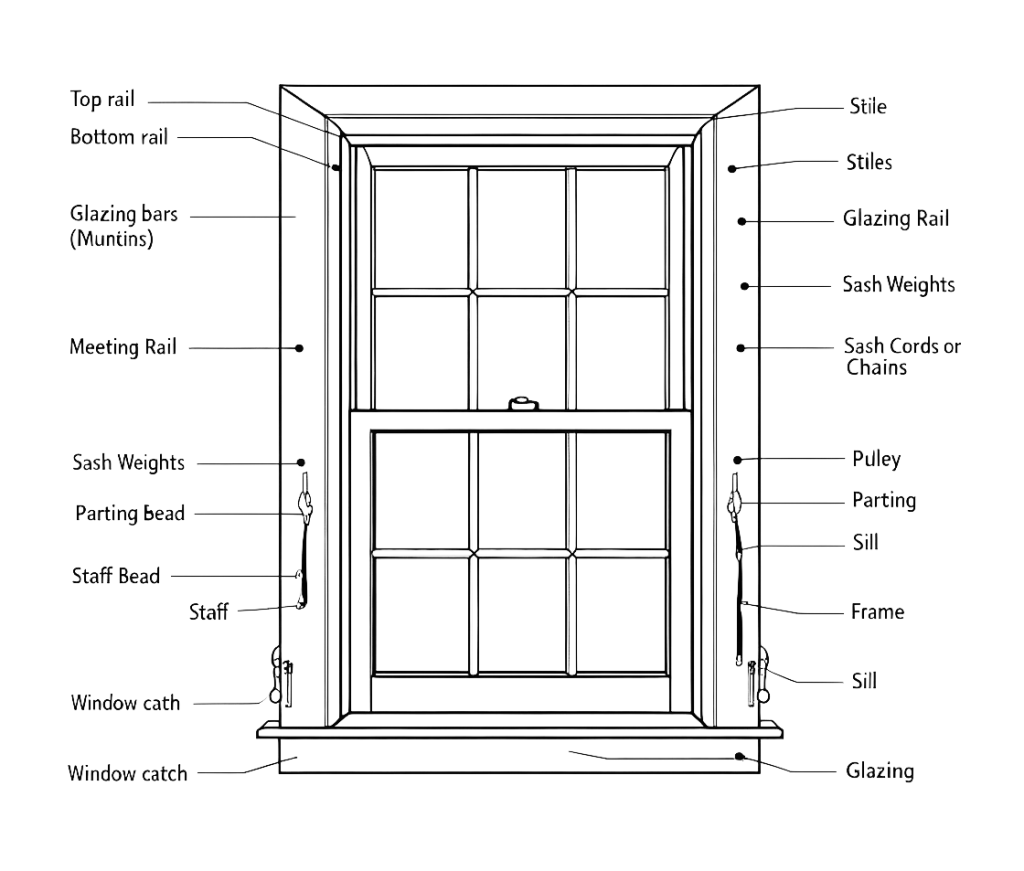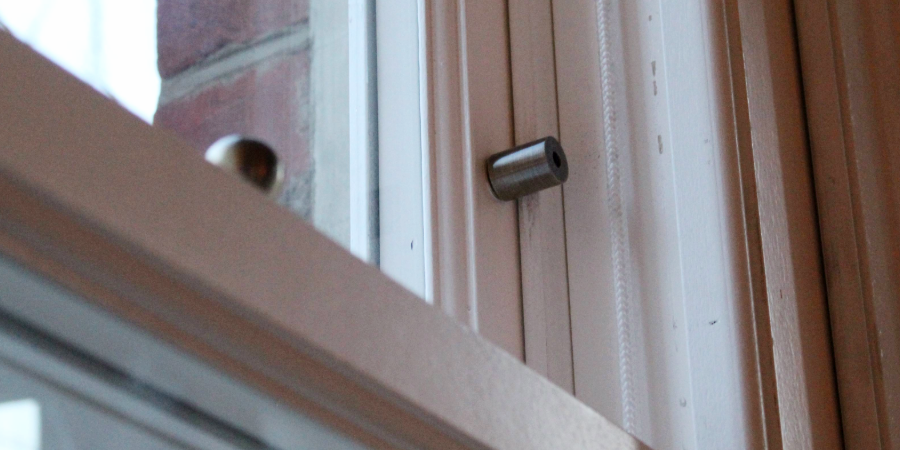Sash windows, renowned for their timeless elegance, are a defining feature of many traditional British homes. They enhance the aesthetic appeal of your property and offer practical benefits like improved ventilation and increased natural light. This guide covers everything you need to know about sash windows—from their design and materials to common issues and replacement options—helping you maintain and maximise the value of your investment.
What Are Sash Windows?
Sash windows contain one or more movable panels, or “sashes,” holding the glass panes. Traditionally, the sashes slide vertically, although some variations move horizontally. These windows are often counterbalanced by weights or springs, allowing smooth opening and closing.
 Key Components of Sash Windows
Key Components of Sash Windows
Understanding the essential components of sash windows can help in their maintenance and repair:
- Top Rail: The upper horizontal frame of the sash
- Bottom Rail: The lower horizontal frame of the sash
- Stiles: The vertical sides of the sash
- Glazing Bars (Muntins): Bars dividing the glass panes
- Meeting Rail: Where the upper and lower sashes meet
- Sash Weights: Metal weights that counterbalance the sashes
- Sash Cords or Chains: Connect the sashes to the weights for movement
- Pulley: Allows cords to move freely
- Parting Bead: Separates the two sashes within the frame
- Staff Bead: Holds the sashes in place
- Sill: The base of the window frame
- Frame: The structure holding the sashes
- Window Catch: The lock mechanism where the sashes meet
- Glazing: The glass panes within the sashes
Timber Sash Windows: A Classic Choice
Historically, timber sash windows were the most common, especially for those looking to preserve the original charm of period properties. Timber provides a classic, authentic look and offers excellent sound insulation due to the natural properties of wood. With regular care, timber sash windows can last for generations, making them a sustainable choice for homeowners.
Double Glazing for Sash Windows
Double glazing is a popular upgrade for sash windows, significantly improving energy efficiency and soundproofing; this involves two panes of glass with a gap between them, reducing heat loss and external noise. Retrofitting double glazing can modernise your home while maintaining its traditional character.
Common Problems with Sash Windows and Solutions
Sash windows, while beautiful, can develop issues over time. With proper maintenance, they can continue to function well for decades. Common problems include:
- Sash Windows Not Staying Open: Worn sash cords or faulty pulleys can cause the window to slide shut. Replacing cords or rebalancing weights will resolve this
- Sash Windows Not Locking Properly: Worn locking mechanisms can compromise security. Replace faulty window catches or misaligned meeting rails to restore proper locking
- Draughts and Poor Insulation: Seals can deteriorate, causing draughts. Installing new draught-proofing strips or refurbishing the frame improves thermal efficiency
- Rattling Windows: Loose fittings or gaps between sashes and frames cause rattling. Refitting sashes or installing new draught-proofing strips can reduce movement and noise
- Rotten or Warped Timber: Timber windows are prone to rot if not regularly maintained. Minor damage can be repaired, but replacement may be necessary for severe cases
- Sticking Windows: Swollen timber, dirt build-up, or dried paint can cause sticking. Sanding, cleaning, and lubricating the sashes can resolve the issue
Sash Window Replacement Options
If the timber is extensively damaged or the mechanisms are beyond repair, replacement may be the best option. Modern sash windows come in various materials:
- Timber: Ideal for period properties, offering traditional charm with modern durability
- uPVC: A low-maintenance option with excellent thermal insulation, available in wood-look finishes
- Aluminium: Highly durable and weather-resistant, with slim profiles that suit contemporary homes
Replacing sash windows is also an excellent opportunity to upgrade to double or triple glazing for better energy efficiency and noise reduction.
Benefits of Well-Maintained Sash Windows
Maintaining sash windows enhances your home’s beauty and improves its comfort and energy efficiency. Whether opting for minor repairs, adding double glazing, or replacing the windows entirely, proper upkeep protects your investment and boosts your property’s value.
Staying informed about the latest materials and technology, such as double glazing and modern draught-proofing systems, allows you to enjoy traditional aesthetics with modern efficiency.
Average Costs for Sash Window Repairs or Replacements
Costs for sash window repairs or replacements can vary depending on the extent of work and materials used:
Window Repair:
- Minor Repairs (e.g. fixing sash cords, pulleys): £150 – £300 per window
- Draught-Proofing: £200 – £400 per window
- Replacing Rotten Timber: £300 – £600 per window
- Full Window Restoration: £500 – £1,000 per window
Window Replacement:
- Timber: £1,000 – £1,500 per window
- uPVC: £500 – £800 per window
- Aluminium: £800 – £1,200 per window
These costs can increase with features like double glazing or custom-made windows.
DIY Maintenance for Sash Windows
- Homeowners can perform several DIY tasks to keep sash windows in good condition:
- Regular Cleaning: Clean the window tracks, glass, and frames to prevent dirt build-up
- Lubricate Moving Parts: Lubricate pulleys and check sash cords to prevent sticking
- Check for Draughts: Install self-adhesive draught-proofing strips to reduce heat loss
- Paint and Seal: Repaint timber frames to protect them from moisture and rot
- Check Locks and Hardware: Replace any damaged locks or fasteners
These simple tasks can prolong the life of your sash windows and avoid costly repairs.
Energy Efficiency and Noise Reduction: Double vs Triple Glazing
Both double and triple glazing offer significant improvements in energy efficiency and noise reduction compared to single-pane windows, but they differ in cost and performance:
Double Glazing:
- Energy-efficient and cost-effective, reducing heat loss and noise
- Costs about £300 – £500 more per window than single glazing
Triple Glazing:
- Offers even better insulation, especially in colder climates.
- Slightly better noise reduction, but the difference may not be noticeable in everyday environments.
- Typically 20-30% more expensive than double glazing.
Double glazing provides the best balance between cost and performance for most homeowners.
Conclusion
Sash windows are a hallmark of traditional British architecture. Whether you need minor repairs, upgrade to double glazing, or consider a complete replacement, maintaining sash windows enhances your home’s beauty, comfort, and efficiency.
At Wandsworth Sash Windows, we specialise in professional services to keep your sash windows in top condition. For expert advice or to discuss sash window replacement, fill out our online form or call 020 7924 7303 for a free consultation.

